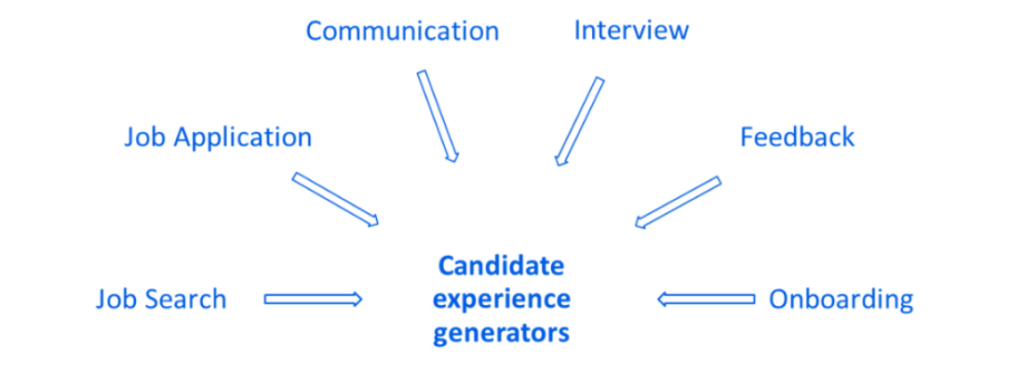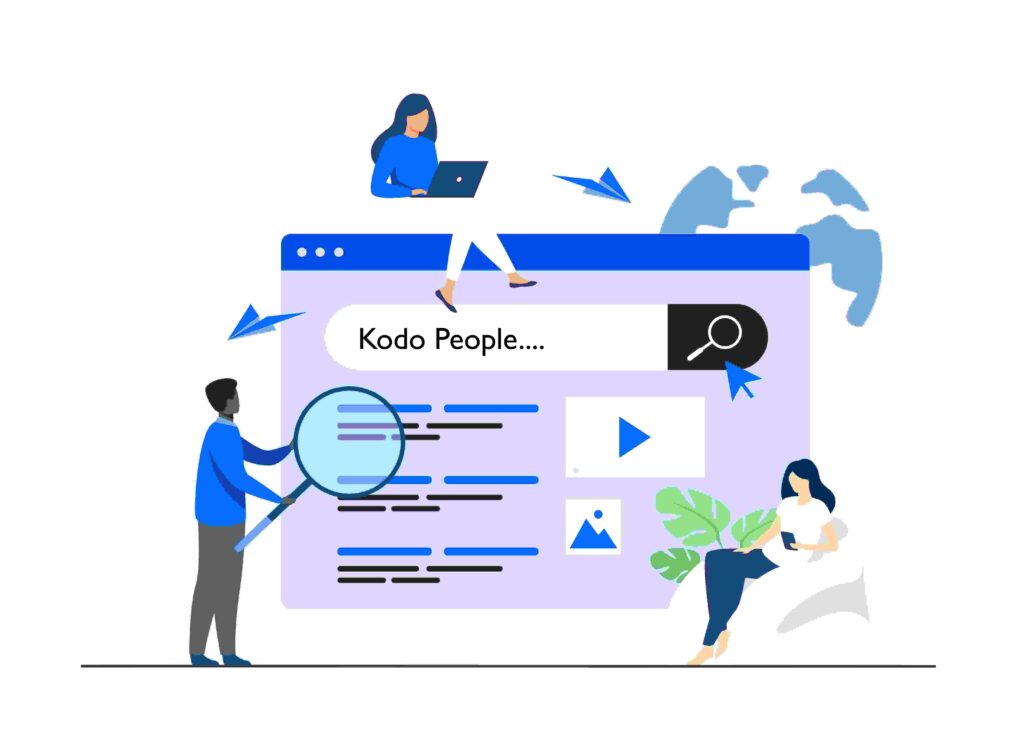
What is candidate experience?
Si quieres leerlo en español haz click aquí
Candidate experience reflects a job seeker’s feelings about going through a company’s hiring process. Enrich employer brand to attract and retain talents – Top priority of C-suite. Read our blog article to get to know the link between candidate experience and employer branding.
Why is candidate experience important for recruiting processes?
It is not hard to see that if negative experiences are shared on social media or, for instance, Glassdoor – a review site with more than 67 million monthly users –, very likely, the employer’s reputation can suffer important losses. Similarly, positive referrals can have the opposite effect, hence improving how other people see the employer. In sum, the employer’s “brand” and reputation are always at stake. Nowadays, providing a great candidate experience should not be seen as an “accessory” of organizations, but rather a fundamental requirement with powerful implications, as the numbers below indicate. And the benefits reach both sides, people and organizations.
How is candidate experience generated?
In an explosive technology era, candidate experience is fermented even before they start applying for a job. A survey of over 4,000 people in 2019 shows that more than 55% of respondents spend more than one hour on each specific employer, looking for related information, before sending out their application. Interestingly, salary is not the only thing job seekers care about, but also the organizational norms and culture. Multiple sources are used nowadays to undercover a company, mainly search engines and non-professional social media, especially by the young.

And remember: every single touchpoint between applicants and companies impacts their experience!
How to improve candidate experience
Enhancing the candidate experience via employer branding strategy, and vice versa. Employer brand is the market perception of how it is like to work for a company. In other words, it mirrors the satisfaction of potential, present, and former workers of employment experience at organizations. The better their public image, the higher pride candidates have once they get admitted, and therefore the easier it is to get talented applicants. According to 2021 Employer Brand Statistics, 72% of recruitment leaders globally feel that employer branding has a major influence on hiring, and 59% are investing more in employer branding. Who does not want the most competent for their team? Therefore, it should not surprise that in 2022, employer branding is seen as a new marketing imperative, and employee experience is the most pivot CMO priority in which attention to the early stage of employment (i.e., candidate experience) is indispensable.

Employer Branding Frame from the Perspective of a Potential Employee (Backhaus & Tikoo, 2004)
Information: Be informative, transparent, and open-minded
The very first impression people have of your company comes when they carry out a simple search on the Internet. Therefore, making vacancies searchable, with a clear description of tasks, transparent payroll, and generous knowledge about organizational culture shared on social media, is a great start and will make the organization more appealing to the candidates.
Furthermore, organizations should encourage applicants to give away their feedback for a more comprehensive view of the hiring process. First of all, people per se want to be understood, so just by listening to their opinion, companies show their sympathy and gain candidates’ affection. Secondly, some talents are rejected not because of ineligibility but of a limited hiring quota. Hence, a good impression toward employers will encourage candidates to apply again. Fast-growth-seeking companies: you don’t want to miss these talents, do you? (Find out more here).

Process: Be explicit, be lean!
What is the average time to hire? According to a study by LinkedIn’s Economic Graph, the candidates who have to wait the longest are in engineering, research, and other high-skilled, high-paying positions: almost 50 days! Why do those generally viewed as extremely qualified need to fall into this discomfort? “Hurry up and wait” makes both recruiters and candidates fatigued, and reduces the chances to land great talents. Yet some companies keep cumbersome hiring processes. This is one of the candidates’ main concerns.
Several factors drive this behavior, including but not limited to a consensus-oriented culture, or the belief that cautious hiring practices will minimize the wrong hires. The former, often confused with collaboration, is poison for rapid decision-making. The latter seems fair, as in some cases it helps companies avoid immense losses in the future. However, in reality, the competition for talents has never been so fierce, and this kind of bureaucratic process eliminates a lot of potential by excluding excellent candidates while providing little value. The historically high number of unfilled jobs, 50% higher than the previous record in the US market, vividly illustrates this. It’s time for you to answer the question: Is it worth it to be intricate when it means leaving money on the table by having vacant revenue-generating positions?
Based on in-house data, Google found that the company could capture 86% of the value created by interviews just in the first four touchpoints. While each extra interview increased predicted accuracy by roughly one percentage point, Google determined that the expense, including the risk of losing prospects, was not worth it. Amazon has opted for four selection rounds per candidate based on a similar premise.
Even if TA managers, who contact candidates directly, realize the ugly truth in lengthy hiring practices, changing organizations’ recruiting might be easier said than done, especially if they are not fully authorized to switch the rules. Henceforth, organizations should embrace a collaborative and accountability-focused culture in which hiring committees can get input from a diverse array of contributors. Yet, someone has to make a decision eventually and be accountable for it to avoid the aforementioned problems associated with a consensus-based approach. Organizations should be clear about whose decision it is and who else might have veto power. Additionally, we encourage recruiters to use synthesized evaluation, making decisions based on the whole picture rather than on isolated (un)favorable comments.

Technology: Update, upgrade, but be humanistic
It is well-documented that technological integration has simplified and empowered the staffing process. Technologies come in a variety, from a modest pop-up chatbox on the main website to respond to any inquiries at any time, to the pricey, sophisticated HR software automating basic and repetitive tasks. Here might come the problems.
Looking only at Capterra – a platform specialized in software reviews –, if we filter for “hiring tool”, 807 results show up, and 643 products if we focus on ATS (Data updated until 9/8/2022). Upon available evaluations, one may get an idea of what the software is about, how much it costs, and so on. However, countless good comments perplex users about which tool they should purchase. In this domain, the only ones who know which solution can be fruitful for the companies are TA specialists, recruiters, HR managers, or Heads of People, who are literally swamped at work, tired of the high attrition rates, and in charge of the complex organization-people relationship.TA pros nowadays strive for a proactive approach to heighten candidate experience. Some have used hiring platforms to get a broader prospect pool and vacancies delivered to the proper targets. Others have employed ATS tools to ensure that interactions with candidates are smooth. Those applying non-traditional evaluation methods, such as behavioral assessments, typically stay ahead because they tend to reach great candidate experience levels. And thanks to the most modern SaaS features, they can assure new hires are assigned the right tasks and work in the most suitable department.
Our advice? Try and try!
We encourage you to TRY, similarly to what happens when you want to buy a new clothing item, stunning photos on the internet and previous buyer compliments cannot guarantee 100% that it will fit you well or that the quality is as in the description.
If you think a video-call interview may make your candidates more comfortable than an in-person one because it’s 40 degrees outside, for example, let them choose the one they prefer. Candidates will appreciate your consideration. If you like an HR tool but are not sure candidates find its interface friendly, look for free trials and collect their feedback later on (usually, providers offer this option even without asking for credit card information), or at least book a demo and take a closer look at the insights of the product. If you think candidates get exhausted from completing a 60-min questionnaire (another typical concern by candidates), try out shorter alternatives or update to another evaluation method, like the funny assessments based on economic games which are becoming trendy and candidates love.
And take into account that while technology is amazing, you also need to use it in the most humanistic way possible (even clever AI can be biased). HR tools and other technology, in general, should complement your organization, like what Jarvis does for Iron Man, helping you facilitate the workload, empower organization-people bonding and eventually improve your employer brand.Again, everyone wants to be understood, and so do the candidates. It’s time for you to get to know your applicants better, and faster (!) to heighten candidate experience, which at the end of the day will strengthen your employer brand.
